The first page is a chameleon realistically doing what chameleons do.
The second page is a snake uncoiling underneath forest floor debris. Also more realistic than fantasy. The page is included for the simple reason that I like this snake and it contributes to the sense of a dense forest not without danger. These two pages are misdirection for what follows.
The third page is the main page depicting the fantasy forest. Its main feature is a tree with mushrooms underneath it that are adapted to tiny improbable cartoonish homes.
The fourth page is a closeup of one of the mushroom houses. The door opens to show a tiny harvest mouse that fills the interior of the mushroom with its little mouse nest in contradiction to the outside appearance of the mushroom house.
The card is backed with black matt board. The cover is a simple ink drawing of a single ordinary mushroom. A doubled black matt window frames the sketch, so four black matts altogether. All the pages, backing, and frame, are bound as a book. The card weighs just short of half a pound.

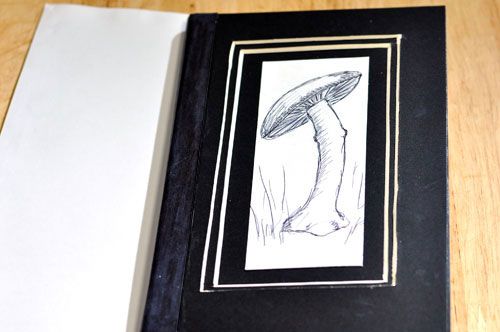
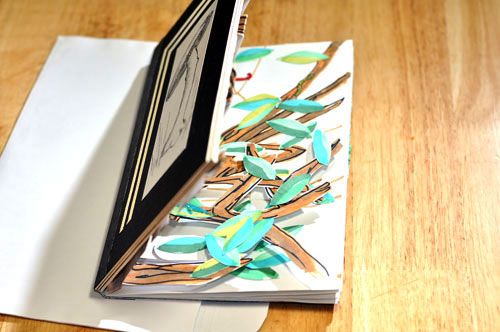
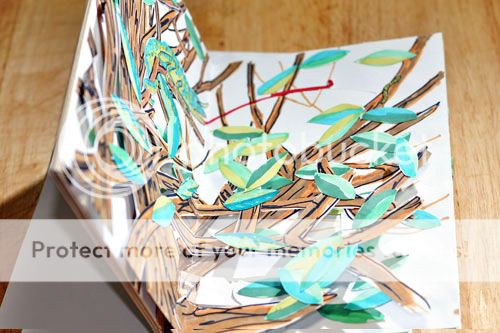

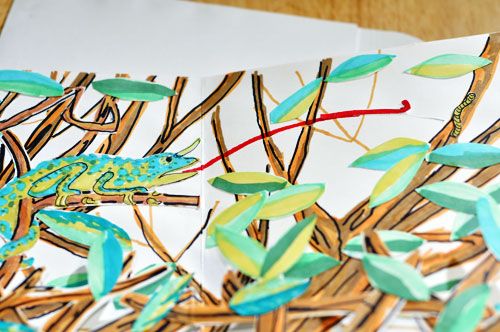

The chameleon's tongue is seen snapping at a caterpillar. A piston arm located at the bottom of the page works when the two pages are opened. The piston arm disappears through a slot on the opposite page and engages a levered arm on the back which is covered and protected. The levered arm creates an arc movement and reappears to the front of the card sliding along a slot cut in the shape of its arc. A portion of the chameleon's tongue is glued to the tip of the levered arm. The first half of the chameleon's tongue is painted directly onto the background. Only the most distant portion of the chameleon tongue travels toward the caterpillar.
Additional branches and leaves are build up on a partial table mechanism. There is actually more space to the table than there is material, but the material that forms the table with exceedingly short legs is sufficient to suggest a dense thicket of branches and leaves.
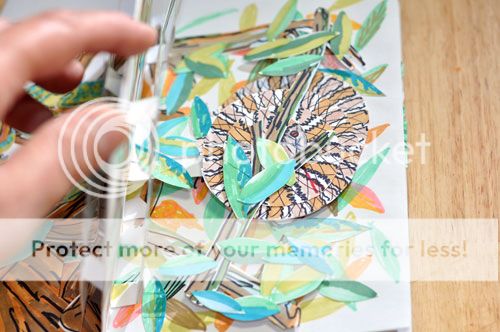
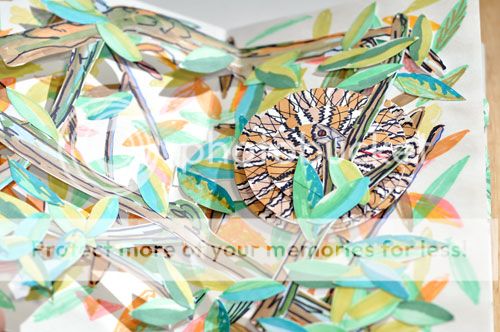

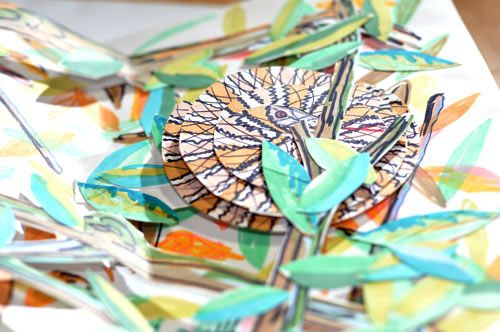
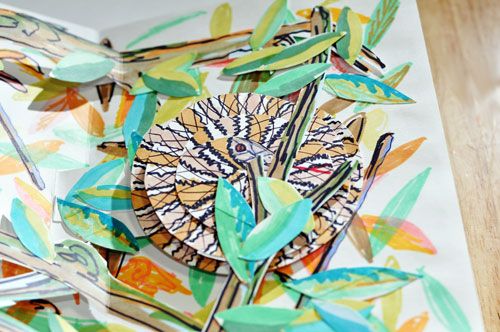
The snake is two discs attached to short arms that in turn are attached to opposing crimps made into the step of a shallow platform. The crimps -- arms -- discs work in opposite directions.
As with the chameleon, another shallow table built up of sticks and leaves obscures the snake and contributes actual depth.
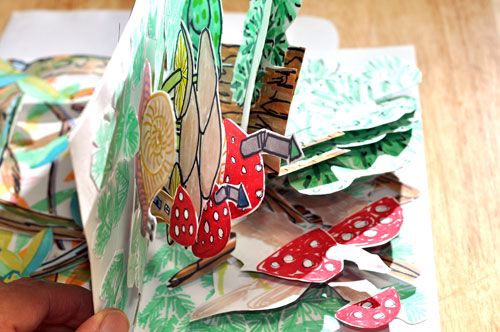
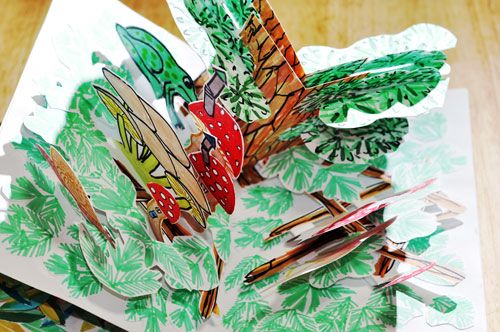
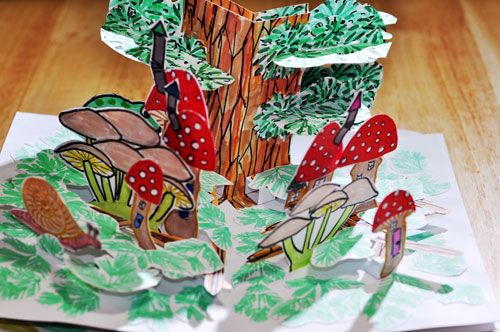
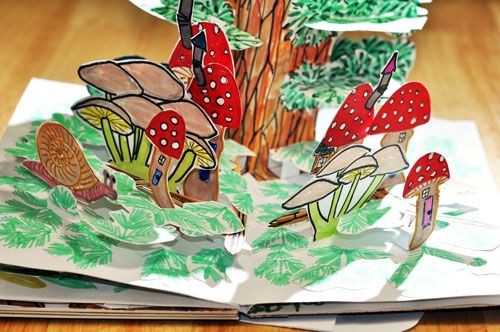
The tree is built on a V mechanism. Like the chameleon page and the snake page, another shallow layer is built up to form a platform of branches and plant life, but this time the mechanism is not a proper table but rather an extension of the tree's V mechanism.
The tree trunk is a double V so doubly strong. All the 1/2" legs to the platform conform precisely to the tree's V shape. The tree trunk V mechanism drags up a dozen or so additional supporting legs that could not operate on their own without being connected to the tree. So the tree pulls with it an entire platform upon which content is attached.
That is the way to visualize it. But the platform was built up the same way as the two previous tables were built up. The V shape is already established by the tree trunk. Guide lines are drawn on the entire background in front of the tree extending outward that exact same V shape. The guide lines amount to a chevron design. Posts comprised of a rectangle of three scored tiny squares are glued to the background randomly but in strict conformity to the chevron pattern. Now one of the scored squares for each rectangular post is glued flatly to the background. Precut content is glued to the second square of the 3-square rectangular post. All additional content conforms strictly to the tree trunk. The content stands upright with the tree. One square of the 3-square rectangular post remains. The last empty square of each post, now glued to the background and with erect content, are connected together to form a matrix upon which is built an airy platform of sticks and leaves, and connected also to the tree so that the platform is lifted with the tree and shoved back down when the tree is folded with the card. The platform and all the content is subservient to the tree. Because of that, it's built loosely and flimsily instead of sturdily and ruggedly.
The fun thing about it is that the posts can be glued together with paper branches and even topped with leaves before being attached to the tree trunk. Finally the entire platform having been constructed backwards in the down folded position, random legs strictly positioned, upright content, platform content, can be lifted up all together at once into position and then attached as slave to the tree trunk. It's how everything flips up at once when the card is opened.
The fun thing about it is that the posts can be glued together with paper branches and even topped with leaves before being attached to the tree trunk. Finally the entire platform having been constructed backwards in the down folded position, random legs strictly positioned, upright content, platform content, can be lifted up all together at once into position and then attached as slave to the tree trunk. It's how everything flips up at once when the card is opened.
[There are different ways to go with this. It's possible to construct a platform on a full chevron pattern comprised of sturdy squarish tubes that operate independently from the tree trunk and with content glued to their front surfaces and that provide a top surface to accept a platform, but to get all those square tubes to fold in unison either on their own or connected to the tree leads to a very paper-heavy result since the entire tube is not used to hold content upright. Using tube sections that are not connected in a complete V and so unable to operate without the tree are still paper-heavy because the entire square tube is not needed. That's because square tubes takes 5 sides as two lengths must overlap in order to form a tube. So this approach used here reduces the 5 sided square segments of a cut up tube to 3 sided partial square segments, the missing side is provided by the tree trunk itself. Clever, eh? It's also very fast and easy to build.]
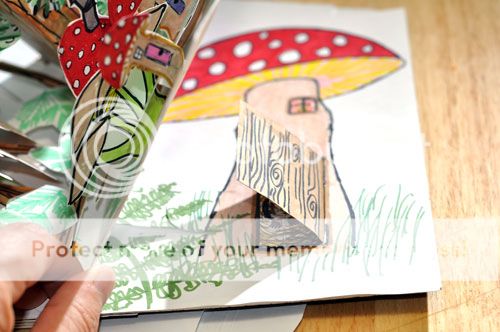



The same piston arm that operates the hidden lever that moves the chameleon's tongue is used in the harvest mouse page to open the door. The door is a hinge attached directly to the piston arm. The door is a scored hinge set through a slot and glued to the piston arm so that when the card is half opened to the 90° position then so is the door. Pulling the card fully open also drags the piston and the door that is attached to it which forces the little door through the slot to a new fully opened position. When the card is closed, the piston is shoved in the opposite direction taking the door hinge behind the slot with it into a new shut position.
And isn't the mouse the cutest little thing? I got tired of drawing leaves so the fern is all scribbles. Actually, all my drawings are just scribbles.
Additional online pages detailing the construction of each individual pop-up page for this card. This card was fairly easy to construct. It uses only a few pop-up mechanisms and there was nothing to figure out in terms of mechanics. All of these mechanisms were used before in other cards.
* page one, chameleon page. Mechanical arm to levered arm to chameleon's tongue, with reticulated table.
* page two, coiling snake. Double crimp mechanism with short connecting arms to discs, with reticulated table.
* page three, fantasy forest. Tree trunk V mechanism with floating platform and upright content.
* page four, mushroom house. Mechanical arm to hinged door.
No comments:
Post a Comment